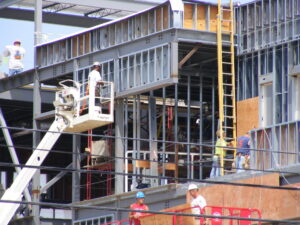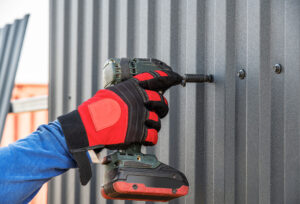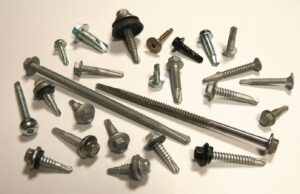Innovations in fasteners meet the challenges of metal construction
by David Flaherty | 6 January 2025 1:18 pm
 [1]
[1]Necessity is the mother of all innovation. While traditional steel bolts and screws served as reliable solutions for the last century and a half, improvements in building design and metal construction have given rise to small but important innovations in fasteners. Among these innovations are changes in size, materials, finishes, and manufacturing techniques. Here is a look at these innovations, their advantages over traditional fasteners, and their broader impact on construction and manufacturing.
Today’s buildings are designed with greater emphasis on energy efficiency while resisting the destructive forces of fire, high wind speeds, and seismic activity, which seem to be ever-increasing. New construction materials and techniques have been developed, requiring fasteners to be longer, more corrosion-resistant and ductile, and transfer less heat.
Along with the challenge of simply designing a safe and comfortable building, there is the challenge of constructing a building with a shrinking workforce. The industry is experiencing a significant shortage of skilled workers due to an aging workforce and fewer young people entering construction trades. High turnover rates are common, as workers often leave the industry for better pay, benefits, or working conditions.
Self-drilling screws
Self-drilling screws are more advanced than tapping screws and traditional screws due to a specialized design that allows them to drill, tap, and fasten in a single operation. These screws have a drill point at the tip, eliminating the need for pre-drilling, making them ideal for projects where time and efficiency are critical. This speed is particularly beneficial on large-scale construction projects. Additionally, fewer tools are needed, and workers require less training for proper installation. By streamlining the fastening process, self-drilling screws reduce installation times and labor needs. They are available in various materials, lengths, and diameters, allowing them to be used across multiple applications.
Recent innovations in self-drilling screws have enhanced durability and efficiency while addressing the need
for ductility. The development of screws with dual heat treatment—which enhances the hardness of the drilling portion while maintaining the ductility of the rest of the screw—is another crucial step. These screws are designed to withstand high-stress environments without exposing them to the risk of embrittlement, making them suitable for applications in structural framing, curtain walls, and solar panel mounting.
Bi-metal screws
Along the same lines are bi-metal screws, which have a hardened carbon steel tip suitable for drilling welded to a stainless steel body. The body is both ductile and embrittlement-free and is also very resistant to corrosion.
As buildings are equipped with thicker insulation layers, self-drilling screws are required and developed in longer lengths, with the size of screws increased to more than 260 mm (10 in.) long.
Varied head and drive styles
 [2]
[2]Different head styles and drive systems have also been introduced. The pancake head is often used where clearance is an issue, and being a low-profile head requires an internal drive system to install the screw rather than an external hex shape.
A cross-recess drive has been improved by introducing the internal square drive and internal star drive. Even newer internal drives like spider drives have been developed for easier installation, reducing tool wear, and lessening damage to the finish of the screw head.
Thermal bridging
Thermal bridging of fasteners gives back some of the efficiency gained by layers of insulation. Steel fasteners can transfer heat between the inside and outside of a building by conduction. While the energy lost through an individual fastener is very small, thousands of fasteners may be used to attach the outside skin of a building. To combat this, a wide range of clips, washers, and brackets are used to thermally isolate the fasteners and stop the heat transfer. Stainless steel has a much lower rate of heat transfer than steel, and the innovative use of stainless steel or bi-metal screws in a cladding system nearly eliminates heat transfer and leads to a simpler design, which may be more cost effective in the construction phase and the lifetime of the building.
Coatings
Coatings have been developed to resist corrosion better and extend the lifespan of fasteners. Screws with long-life coatings can now match the corrosion resistance of roof and wall panels. These coatings bridge the gap between high-cost stainless steel fasteners that are highly corrosion-resistant and low-cost zinc-plated fasteners that do not hold up to the outside environment over the decades. Due to exposure to harsh environmental conditions, including saltwater, extreme temperatures, and high humidity, an ever-growing demand for corrosion-resistant fasteners exists.
Tension control bolts
 [3]
[3]Another innovative fastener type is tension control bolts or TCBs. These are high-strength bolts with a breakaway extension at the end that allows for precise tensioning and ensures consistent, proper installation. TCBs connect structural steel frameworks for buildings and bridges.
TCBs and the tools used to install them solve some of the same challenges as self-drilling screws. The shear wrench used to install a TCB makes the process quicker and requires less skill than traditional bolting or welding. Unlike impact wrenches, shear wrenches operate quietly, improving working conditions and reducing workplace hazards. The shear wrench holds the spline in place and tightens the nut until reaching the designated tension. At that point, the spline shears off. Its absence quickly verifies that the bolt is properly tensioned. TCBs provide more consistent tension and easier inspection than traditional bolts, which involve more manual verification and are subject to variability in torque application.
Recent innovations with TCBs include cordless shear wrenches, eco-friendly coating, and expanded sizes. Cordless shear wrenches eliminate cumbersome power cords and generators, making installation more convenient and flexible, especially in confined or remote locations. This development has been well-received across industries for its efficiency and portability. Like other fasteners, newer, environmentally friendly, and
anti-corrosion coatings offer enhanced durability compared to traditional zinc plating and galvanization. They are also compatible with various paint systems. New larger sizes—M27, M30, and M36—have been introduced in the last decade to accommodate modern architectural needs, including space-saving designs and visually appealing connections.
The future of fastener technology lies in continuously adapting to the construction industry’s evolving needs. As construction projects grow in complexity and demand higher efficiency, the role of fastener technology will remain as important as ever. New innovations will change the way modern structures are connected and secured. These advancements will continue to improve durability, energy efficiency, and safety while easing labor challenges and creating better buildings across the industry.
Josh Krohn is the engineering service manager at Triangle Fastener Corporation. He has 24 years of experience as an engineer and has headed up the TFC Tech Center in Cleveland since 2018.
- [Image]: https://www.metalconstructionnews.com/wp-content/uploads/2025/01/GC_JOB.jpg
- [Image]: https://www.metalconstructionnews.com/wp-content/uploads/2025/01/GettyImages-1489501685-1-web.jpg
- [Image]: https://www.metalconstructionnews.com/wp-content/uploads/2025/01/self-drilling.jpg
Source URL: https://www.metalconstructionnews.com/articles/innovations-in-fasteners-meet-the-challenges-of-metal-construction/